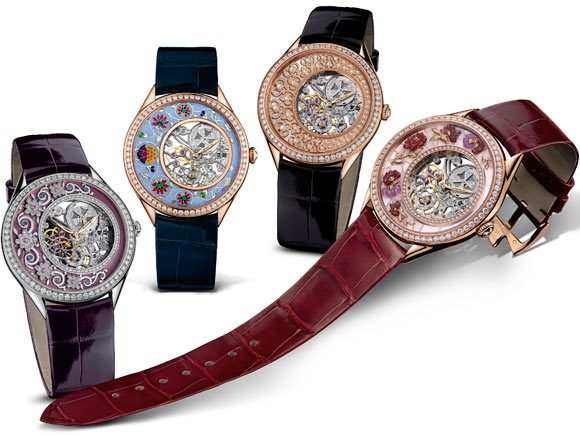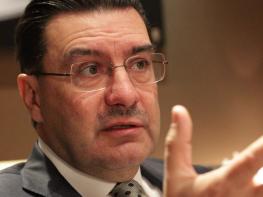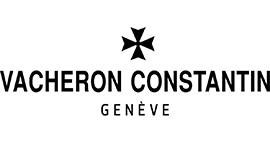David Chokron: Vacheron Constantin is presenting a range of new models that are almost all openworked. Why so?
Juan Carlos Torres: There was one particular craft that we had never yet highlighted, that of openworking. Everyone talks about artistic crafts, but nobody had so far raised openworking to that stature. It is simply not the same engraving skills as that involved in working with a case or dials. It does involve the same touch, the same motifs, nor the same degree of pressure. There can be no flaws; everything must be perfect. It is a little-known skill. An openworked model is deliberately developed and not improvised. Engineers and designers work together to create the mechanism, its various forces and its components in such a way that when its operation is not impaired even when 70% of the material is removed. For example, when we developed our ultra-thin minute repeater, we created its openworked version at the same time.
Is this an historical heritage?
Vacheron Constantin has been making openworked models since 1780. This concept has always been a part of our approach watchmaking, as expressed in perpetual calendars and ultra-thin models, but we had never turned the spotlight on it. Last year, our SIHH was all about ladies’ models, and this year, we are introducing openworked creations for both men and women. To showcase the technical prowess involved, we have two exceptional and highly complicated watches. We have introduced Calibre 1003 complete with its own artistic crafts into the ‘Fabuleux Ornements’ collection. From an inside perspective, it is important to remember that a brand such as ours must perpetuate various skills: traditional watchmaking is our fundamental vocation. Our new watchmakers must be given opportunities both to look back at the past and to look forward to the future. We have also taken this approach in order to give them responsibilities, since their average age is considerably lower than before. They had never before handled openworked mechanisms, and this time they were given an abundance of them to work with.

(To view the slideshow, click on the picture on top of the page)
What was the inspiration?
The challenge facing our designer was to create clever openworked mechanisms. For example, on the 14-day tourbillon model, the strongly architectural design stems from the idea of torsion. They give the impression that certain parts have been twisted, but this is done by chamfering (bevelling). This involves working with the engraving team to find another dynamic. For me, an openworked movement must be decorated, so there was no question of simply leaving surfaces smooth.
Nonetheless, the transparency effect can be a double-edged sword on a men’s wrist…
Sure, but constantly wearing watches eliminates any hairs (laughter).
Might one say that the “Fabuleux Ornements” watches are your favourites?
I love them. It’s been a long time since we introduced such romantic, lyrical and elaborate models. Grand Feu enamelling and cloisonné, cloisonné opal: we have taken things extremely far in terms of research into glyptic – and we did it all in-house. These are not toys; they are true horological works of art. They will be as valuable as ever in 10, 20 or 40 years’ time.
Aren’t these models mainly sold in China?
Mainland China is actually where I sell less of these watches than anywhere else. On the other hand, our customers are particularly discerning in Hong Kong and Taiwan, as are the Chinese communities in London and the United States. What is special about us is that we take China seriously. When we began to be established there, watches reached us in terrible condition. These were models that had been hidden away by families. We restored them and that created an amazing buzz, heightened by the wind of openness and change. We have opened after-sales service centres in Shanghai and Beijing. We have also opened boutiques in ‘small’ cities with a million or so inhabitants. We currently have 25 points of sale, and we still haven’t really reached the interior of the country. I am confident about China, because we don’t treat it like a cash cow.

« Dans deux ans, nos mouvements serons 100% manufacture. »
How do you see your movements evolving?
In two years’ time, our movements will be 100% in-house manufactured, including a self-winding chronograph calibre. We have a joint development platform with Roger Dubuis. In the beginning, everyone told me we couldn’t do this, and yet the watch industry was built in just that way. It’s always been about shared developments, particularly in the Vallée de Joux. We put our teams together, each with its own style and its specifications. I needed a sports chronograph. At the end of the process, the products will not be identical. A maximum 30% of the parts will be the same. And our future hand-wound chronograph will be made in the Vallée. Next year, for Vacheron Constantin’s 260th anniversary, you will see a firework display of products entirely crafted in-house. And then 2016 will bring the 20th anniversary of the Overseas collection.
How is Vacheron doing on the American market?
That’s actually a pleasant surprise for us. For years, we had certain problems there in the past, because we didn't have the right organisation or the right products – as well as because Patek Philippe enjoyed complete dominance. That dominance is still there, but we are steadily earning market shares year by year. Our points of sale at New York and Rodeo Drive have raised our service level. There is an extremely refined clientele in Los Angeles, and that’s where I sell the greatest number of simple Patrimony models and dress watches in general. The United States has become our second market, ahead of Europe.
Can we talk figures?
We produce around 30,000 watches, and we have been hiring around 150 to 200 new staff annually for the past seven or eight years. Training an experienced watchmaker takes as long as for a doctor. But I don’t like the idea of focusing on quantities produced. We prefer to reckon more in terms of the number of hours of work involved.
How will your distribution evolve?
We have our developed our boutiques in the world’s great cities, and in places where the distribution was not structured by the retailers, such as Brazil. We have trimmed the network from 550 to 300 points of sale. We are not going to continue reducing that number but will instead be opening various points of sale, mainly with partners. I will not open in Milan or Rome without my local partner. We are not yet present in Japan, nor in Miami nor in Latin America, so there is plenty of scope for development, and who knows how the world is going to grow?





